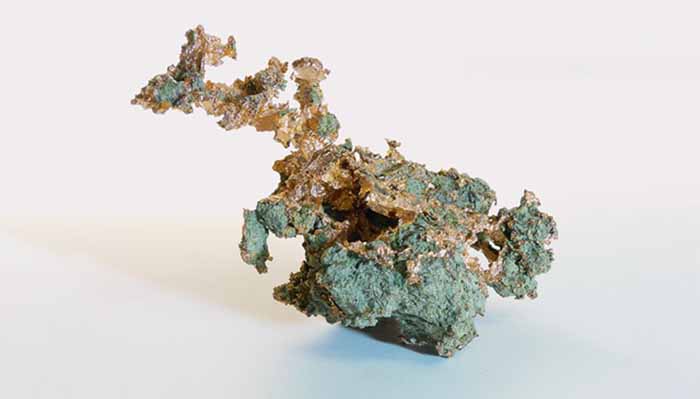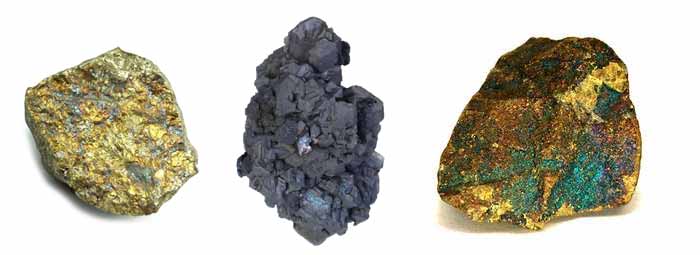1 Types of copper sulfide ore
(1) Single copper mineral Its ore characteristic is relatively simple, and the only useful component that can be recycled is copper. The gangue minerals are mainly quartz, carbonate and silicate.
(2) Copper-sulfur ore Called copper-bearing pyrite. In addition to copper minerals, iron sulfide can be recovered, and the main mineral of sulfur is pyrite.
(3) Copper pyrite ore Except for the copper minerals, pyrite and magnetite are worth recovering. Many of the skarn-type copper mines in China belong to this type.
(4) Copper-molybdenum ore Contains molybdenite and copper, some mine also can recover magnetite and pyrite.
(5) Copper-nickel ore Copper minerals and nickel, such as nickel sulfide ore and nickel-containing pyrite and pyrrhotite.
(6) Copper-cobalt ore Copper mineral and cobalt-containing pyrite and other cobalt minerals.
(7) Arsenic sulfide copper ore The ore has a high content of arsenic, which is mainly in the form of arsenopyrite. Flotation process to solve the problem of copper and arsenic separation, reduce the arsenic content in the copper concentrate as much as possible.
Related post: Copper Ore Types and Distribution in the World
2 Main copper sulfide minerals and their floatability
There are many kinds of copper sulfide minerals in nature, but the main copper sulfide minerals with industrial value are chalcopyrite, chalcocite, porphyrite, covellite, tetrahedrite, tennantite, etc.
(1) Chalcopyrite (CuFeS2) Chalcopyrite (including Cu 34.57%) is the most common copper mineral in China’s copper mines, has good buoyancy. Chalcopyrite is not easily oxidized, and it can maintain natural floatability for a long time in neutral and weakly alkaline pulps. However, in a strongly alkaline (pH>10) slurry, since the surface is eroded by OH-, a hydrophilic iron hydroxide film is formed, and the floatability is deteriorated. The chalcopyrite located on the surface of the deposit is oxidized for a long time, with low hardness, easy to be pulverized, and the floatability is also deteriorated.
The most commonly used collector for flotation chalcopyrite is xanthate, chalcopyrite is easy emerged in a wide pH range (3 to 12). Chalcopyrite is susceptible to inhibition by cyanide and oxidants in the alkaline pulp. Excess lime and sodium sulfide and ammonium sulfide inhibit chalcopyrite in alkaline slurries.
(2) Chalcocite (Cu2S) The chalcocite is one of the most common associated copper minerals. It is brittle and easy to be crushed and muddy. It has good floatability in both acidic and alkaline pulps. Chalcocite exists in the many large scale porphyry copper deposits at home and abroad.
The chalcocite is more oxidized than the chalcopyrite, copper ions enter the slurry, complicating the flotation process and increasing the difficulty of separating.
The collectors of chalcopyrite are mainly xanthate and Aeroflot. The effective inhibitors are sodium sulphate, sodium sulfite, potassium ferricyanide and potassium ferrocyanide. A large amount of sodium sulfide also inhibits the chalcopyrite, and cyanide has a weak inhibitory effect on the chalcopyrite.
(3) Bornite ore (Cu5FeS4) The bornite has the original type and associated type, its floatability performance is between the chalcocite and chalcopyrite.
Other copper sulfide minerals, such as covellite (CuS), are similar in floatability to chalcopyrite. The buoyancy of tetrahedrite (4Cu2S·Sb2S3) and tennantite (4Cu2S·As2S3) is similar to that of chalcopyrite.
3 Summary of the copper mineral flotation process
(1) Copper minerals (such as chalcopyrite and covellite) that do not contain iron are similar in floatability. Cyanide and lime have weaker inhibition on them, so a large amount of lime can be added to inhibit pyrite in the separation of copper and sulfur without seriously affecting the floatability of copper minerals.
(2) The copper minerals (such as chalcopyrite and porphyry) contains iron is similar in floatability, and are easily inhibited by cyanide and lime in alkaline pulp, so the separation of copper and sulfur is difficult and need to control the amount of cyanide and lime strictly.
(3) As for the chemical content, high copper content, good flotability, and easy to obtain high-grade concentrate; high iron content, poor floatability. The floatability of common copper sulfide minerals is reduced in the following order: chalcopyrite > covellite > bornite > chalcopyrite.
(4) The floatability of copper sulfide minerals is also affected by factors such as crystal grain size, grain size, etc. fine grain is not easy to float.
Where to buy suited flotation machines and chemical agents?
JXSC, a provider of mineral processing equipment and solutions, has been supplying reliable copper mining machines for more than 35 years, evergrowing experience and knowledge make us go further.
Successful mineral processing plant cases involve the extraction of copper, gold, diamond, zinc, titanium, iron, manganese, tungsten, chrome, and so on.


